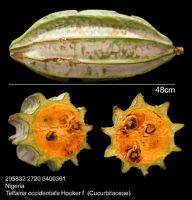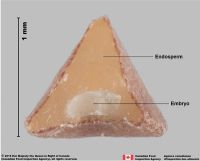Content is from Kirkbride et al. 2006Kirkbride et al. 2006:
Kirkbride JH, Jr, Gunn CR, and Dallwitz MJ. 2006. Family guide for fruits and seeds, vers. 1.0. Accessed September 2020-January 2022. URL: https://nt.ars-grin.gov/seedsfruits/keys/frsdfam/index.cfm ., without modification.
Updates are forthcoming.
Cones: Dry; simplesimple:
fruit formed from a single flower with one pistil, solitary carpel or several fused carpels
when dry; elliptical, or globoseglobose:
3D shape—more or less spherical , or ovoidovoid:
, or ovoidovoid:
3D shape—ovate ; symmetrical; with sporophylls; with scalelike sporophylls. Fruiting scalelike sporophylls compacted tightly.
; symmetrical; with sporophylls; with scalelike sporophylls. Fruiting scalelike sporophylls compacted tightly.
Seeds: Arilaril:
(broad sense) appendicular structure that wholly or partly envelops a seed and is produced from or a modification of the funicle, raphe, or outer integument; usually fleshy or pulpy, sometimes spongy or tufted-capillate, often brightly colored absent. Seed larger than minute; 10 to less than 25 mm long, or 25 to less than 50 mm long; 25–35 mm long; angularangular:
absent. Seed larger than minute; 10 to less than 25 mm long, or 25 to less than 50 mm long; 25–35 mm long; angularangular:
2D shape—having sides that meet at acute or obtuse angles
, or oblongoblong:
2D shape—much longer than broad with nearly parallel sides, corners are rounded , or ovateovate:
, or ovateovate:
2D shape—egg-shaped in outline, widest point is towards one end of the organ, the other end tapers gradually, attachment at or near the broad end (compare obovate, ovoid) ; in transectiontransection:
; in transectiontransection:
a cross section; representing a plane made by cutting across an organ at a right angle to its length tereteterete:
tereteterete:
approximately circular in cross section; width and thickness approximately equal
 ; not bowl shaped; not nutlike; without winglike beakbeak:
; not bowl shaped; not nutlike; without winglike beakbeak:
a usually firm, terminal appendage, sometimes tapered ; without caudatecaudate:
; without caudatecaudate:
tapering to a long, tail-like appendage appendage(s); at maturity with food reserves; with endospermendosperm:
appendage(s); at maturity with food reserves; with endospermendosperm:
nutritive starch- and oil-containing tissue present in many seeds ; without canavanine. Sarcotestasarcotesta:
; without canavanine. Sarcotestasarcotesta:
pulpy or fleshy outer layer of the seed coat, simulates aril present; fleshyfleshy:
present; fleshyfleshy:
texture—fairly firm and dense, juicy or at least moist, and easily cut
. Testatesta:
seed coat
 present; with fleshyfleshy:
present; with fleshyfleshy:
texture—fairly firm and dense, juicy or at least moist, and easily cut
or leatheryleathery:
texture—moderately thick, tough, and very pliable
layer over hard layer; tight; surface smooth (but with a plate); without crease or line separating cotyledons from hypocotyl-radicle; without notch along margin where cotyledons from hypocotyl-radicle tip approach each other; without glands; without bristles; glabrousglabrous:
without hairs
; without wings; without collar; without operculumoperculum:
a dehiscent cap (or lid) of a seed or fruit that opens during germination or dehiscence
 ; colored; monochrome; purple (ish), or red, or yellow (ish); not becoming mucilaginousmucilaginous:
; colored; monochrome; purple (ish), or red, or yellow (ish); not becoming mucilaginousmucilaginous:
resembling mucilage; moist and sticky
when wetted; surrounding food reserve. Endospermendosperm:
nutritive starch- and oil-containing tissue present in many seeds copious; without fatty acid containing cyclopropene; without apicalapical:
copious; without fatty acid containing cyclopropene; without apicalapical:
at or pertaining to the end of the seed or fruit distal from its point of attachment (i.e., base)
lobes; without chlorophyll; without isodiametric faceted surface; without odor. Embryo differentiated from food reserve; well developed; partially filling testatesta:
seed coat
 (with food reserve); at one end of seed not extending into a depression or cup; without coleorhiza; without simmondsin; without stomata; not green; with 2 or more cotyledons. Cotyledons 2; equal in size; not punctatepunctate:
(with food reserve); at one end of seed not extending into a depression or cup; without coleorhiza; without simmondsin; without stomata; not green; with 2 or more cotyledons. Cotyledons 2; equal in size; not punctatepunctate:
surface relief—dotted with pits or with translucent, sunken glands or with colored dots, similar to pitted dotted.
dotted.
Literature specific to this family: Dyer, R.A. 1966. Stangeriaceae. In: L.E. Codd, B. de Winter, & H.B. Rycroft, eds., Flora of southern Africa,vol.1, pp. 1–3. Cape & Transvaal Printers Ltd., South Africa; Jones, D.L. 1993. Cycads of the world. Reed New Holland, Sydney; Stevenson, D.W. 1990. Morphology and systematics of the Cycadales. Mem. New York Bot. Gard. 57:8–55.
General references: Flora of Australia (various years & volumes). Australian Government Publication, Canberra, Gunn, C.R., J.H. Wiersema, C.A. Ritchie, & J.H. Kirkbride, Jr. 1992 & amendments. Families and genera of Spermatophytes recognized by the Agricultural Research Service. Techn. Bull. U.S.D.A. 1796:1–500, Mabberley, D.J. 1987. The plant-book, 706 p. Cambridge University Press, Cambridge, and Johnson, L.A.S. & K.L. Wilson. 1990. Cycadophytina/Cycadatae with the single living order Cycadales (Cycads). In: Kubitzki, K., ed., The families and genera of vascular plants, pp. 362–377. Springer-Verlag, Berlin.